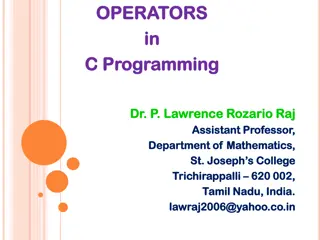Understanding Classification and Division Essays
Exploring the concepts of classification and division in writing, this content delves into how these essays explain topics by categorizing types or parts. It outlines the characteristics, purpose, and components of classification and division essays, providing examples and insights to help enhance your understanding.
Download Presentation

Please find below an Image/Link to download the presentation.
The content on the website is provided AS IS for your information and personal use only. It may not be sold, licensed, or shared on other websites without obtaining consent from the author. Download presentation by click this link. If you encounter any issues during the download, it is possible that the publisher has removed the file from their server.
E N D
Presentation Transcript
CHAPTER 17 17 CHAPTER Classification and Classification and Division Division: Explaining : Explaining Categories and Parts Categories and Parts
Contents of Chapter 17 Contents of Chapter 17 Characteristics of Classification and Division Essays Reading: My Secret Life on the McJob: Fast Food Managers, by Jerry Newman Visualizing a Classification or Division Essay: A Graphic Organizer Reading: The Language of Junk Food Addiction: How to Read a Potato Chip, by Michael Moss Integrating Classification or Division into an Essay Reading Actively and Thinking Critically What to Look For, Highlight, and Annotate Analyzing Classification and Division
Contents for Chapter Contents for Chapter 17 17 A Guided Writing Assignment Readings: Classification and Division in Action Student Essay: The Useand Abuse of Facebook, by Allison Cava Classification and Division Combined with Other Patterns: The Dog Ate My Flash Drive, and Other Tales of Woe, by Carolyn Foster Segal Applying Your Skills: Additional Essay Assignments
What Are Classification and What Are Classification and Division? Division? A classification or division essay explains a topic by describing types or parts. Classification is a process of sorting people, things, or ideas into groups or categories to help make them more understandable. Division, conversely, takes one item and breaks it down into parts.
Characteristics of Classification Characteristics of Classification and Division Essays and Division Essays Classification and Division groups and divides ideas according to one principle. has a clear purpose and audience that drive the writer s choice of a principle. uses categories and parts that are exclusive and comprehensive. fully explains each category or part. includes a thesis. Reading My Secret Life on the McJob: Fast Food Managers, by Jerry Newman
Reading The Language of Junk Food Addiction: How to Read a Potato Chip, by Michael Moss
Integrating Classification or Integrating Classification or Division into an Essay Division into an Essay 1. Avoid focusing on why the classification or division is meaningful. 2. State the principle of classification briefly and clearly. 3. Name the categories or parts.
Reading Actively and Reading Actively and Thinking Critically Thinking Critically What to Look For, Highlight, and Annotate 1. Preview. 2. Understand the principle of classification or division and the category or parts use. 3. Identify how the writer explains each part or category. 4. Think about the meaning. 5. Consider your reactions. (continued)
Analyzing Classification and Division Does the classification or division cover all significant categories or parts? Does the writer provide sufficient detail about each category? Is the principle of classification or division appropriate given the writer s purpose?
A Guided Writing Assignment A Guided Writing Assignment Your Essay Assignment Prewriting 1. Select a topic, devise a principle of classification or division, and list the categories. 2. Consider your purpose, audience, and point of view. 3. Generate supporting details. (continued)
A Guided Writing Assignment A Guided Writing Assignment Organizing and Drafting 4. Draft your thesis statement. 5. Choose a method of organization. 6. Draft your classification or division essay. Revising 7. Evaluate your draft and revise as necessary. Editing and Proofreading 8. Edit and proofread your essay.























